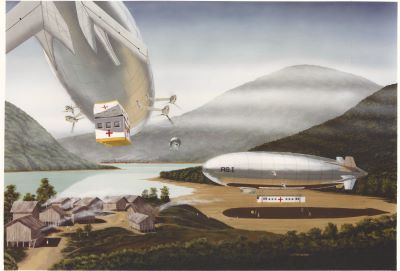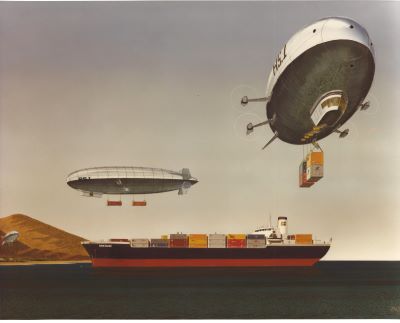|
Statistics
|
| Length |
420
ft |
| Diameter |
83
ft |
| Height |
62ft |
| Speed
|
149.3
mph |
| Engines |
4x
TPE 331-15 turboprops |
| Volume |
1,592,000ctf |
| Total
Lift |
15,000lbs
with ABC Hornet Engine, reduced to 12,000lb with Rolls Royce
engine |
| Passenger
Capacity |
Up to 180 depending on
configuration |
| Disposable
Lift |
3.75
tonnes |
|
PHOTO
GALLERY
|
 |
|
Concept Art
R.30
|
 |
|
Concept Art
RS.1
|
 |
|
RS.1 Car Ferry
Layout
|
 |
|
RS.1 Maritime
confifuration layout
|
 |
|
RS.1
Plan showing the Sea Patroll variant in plan
|
 |
|
RS.1 Passnger
configuration layout of the main gondola
|
 |
|
RS.1 Vecotored
Thrust assembly detail
|
 |
|
RS.1
Bow Thruster detail
|
 |
|
Concept
Art showing the RS-1 in a medical emergency role with removable
medical facility
|
 |
|
Concept
Art showing the RS-1 in a ship to shore cargo tranfer role.
|
 |
|
Concept
Art showing the RS-1 remote freight delivery role.
|
| |
 |
| |
Wren
Skyships
RS1
Introduction
It was in early 1972 that
a company by the name, Mercantile Airship Transportation Limited
( MAST ) formed for the development of large rigid airships. Major
M.W. Wren was the Managing Director. In
1978: Thermoskyships Limited ( TSL ) formed in the Isle of Man
and acquired MAST in early 1979. Major M.W. Wren was the Chairman
and Chief Executive. As a Public Limited Company it raised £2.4
million on the London Stock Exchange towards the development of
an unconventional rigid airship.
The company had been looking
at a series of design concepts, one being the design concept of
lenticular airship design (dubbed flying saucers) which included
the proposal of using heating of the lifting gas to control buoyancy.
The idea that there was a place for airships to fulfill a transportation
gap between fast jet air transport, and slower sea transportation.
It was then that Malcolm Wren and Roger Munk, realised the value
in joining forces, as Munks Airship Developments had already proved
the concept of smaller airships with the AD 500. The resulting
merger of took place a year later on 29th May 1980, with Thermo
Skyships purchasing the company for £1 million. The merger
saw the prospect of putting both a large rigid and a smaller non
rigid design airship in to production.
The resulting merger, in
July 1980, Thermo Skyships name was changed to Airship Industries
Ltd.(AI). During the approximately two-and-a-half years the Thermo-Skyships
team spent at AI, it proposed several abortive designs, for non-lenticular
rigid airships. Much money had already been put in to the Thermo
Skyship company and it had grown to a 30 strong design team. The
idea being that the non-rigids AI designed ships would provide
an income to build the larger and now ellipse shaped 100 seat
passenger ferry airship for intercity use. However it soon became
clear that the two airship projects could not share the same design
lines and concepts.
Wren Skyships
Limited
A de-merger from Airship
Industries in the 1982 saw the split away from the group of a
smaller company headed up by Major Malcolm Wren, and the creation
of Wren Skyships Ltd. the reason for this was due to the different
design approaches for airships undertaken by both organisations
and the structural design question of airships. Wren Skyships
Limited was formed from key members of the rigid division of AIL
and began operating with Major M.W. Wren as Chairman and Chief
Executive, P.W.C. Monk as Technical Director and J.A. Dean as
Chief Accountant. It took over the Isle of Man premises of AIL
and had two subsidiary companies :-
a) American Skyship Industries Inc., formed in July 1982 and based
at Lansdowne Airport, Ohio.
b) New Zealand Airships Limited
Original project ideas from
the company, such are the R.30, which was a 1.1 million cubic
feet airship, as a design response to the US Coastguard requirements
during the U.S. President Jimmy Carter administration. The hull
would be of aluminum alloy,Alelad 2024-T3 with a thickness range
of .010 to .025 in. Supported by 24 longitudinal and 14 ring frames
two of which would be heavy duty to support engines and loads.
It would not have individual gas cell, the metal hull covering
being itself the gas container for simplicity and weight saving.
On operating and flight costs,
the R.30 as a cargo carrier was claimed to be superior to a Boeing
737 aeroplane for ranges up to 600-700 miles, while an early 1980's
study of a passenger version between Paris and London city centres
at 45 minute intervals using (using 6 airships), showed taking
30% of the existing traffic and making 40% profit after allowing
£10m each for the two city centre terminals.
Studies were also made of
the R.30 in a naval role, usually regarded as a non-rigid reserve.
The view that non-rigids are cheaper to produce than rigids and
were starting to prove themselves at the time. Another advantage
of a non-rigid airship was that they could be manufactured and
assembled in different places removing a possible constraint of
the need for hangar space. The idea of a "metalclad"
airship was to improve on the concepts gained by by the US Navy
with their non rigid experience.
The Chief Designer, Mr Pat Monk, (not to be confused with Roger
Munk of Airship Industries) joined the company in 1980 from New
Zealand Aerospace, and the Wren Skyships Design team, engaged
in designing a sophisticated, metal clad airship, the RS.1.
In 1982, the R.30 concept
was later redesigned as the RS.1 and was to be 420ft long with
a maximum diameter of 83.25 feet. Two balloonets would give it
a pressure height of 5,000 ft, and hold a 1,592,000 cubic ft of
gas. The RS.1 would be powered by 4 Airesearch TPE 331-15 turboprops.
The design speed at flying at 5,00ft would be 149.3 mph, or at
sea level cruising with 3 of the 4 engines at 121 mph. The gondola
would be be able to carry out as a multi configurable layout,
being some 120ft long and 17ft wide.
At the time the RS.1 was
designed as much larger than the Airship Industries Skyship 600,
it's contemporary non rigid ship, and similar in concept to the
successful US Navy type ZMC2. In 1987, the concept RS.1 proposed
as a 25 tonne payload ship for surveillance, search and rescue,resource
development and relief work.
The RS.1 concept had a very interesting vectored thrust control,
with the power unit being housed in the stub of a short stub wing,
which would turn through 180 degrees to assist with control on
takeoff and landings. As the stub wing could only rotate through
180 degrees in the forward, up or down position, it was designed
with a "bow thruster" in the nose of the ship which
would provide more control of the airship.
The tail configuration was
decided as the X fin for more control.
RS.1 Multi
Role Configuration
A number of configurations
were proposed for the RS.1 and these included:
Car Ferry:
including an ingenious
"roll on roll off" configuration consisting of "clam
shell doors" both forward and aft. The vehicles would access
via a ground based ramp, and then be parked in on the vehicle
deck. The passengers would then move to the seating area, consiting
of 80 seats, positioned 40 per side of the gondola. There would
be toliet and galley provisions available. In this configuration
the flight deck would be separated and be re-positioned above
the front accommodation access doors.
Maritime
Patrol:
as a long range
and endurance patrol craft co-operating with regular Naval and
Military forces. The gondola would carry a an all weather seaboat
tender for direct intervention at sea. As a search and rescue
patrol craft, with the ability to accommodate 200 survivors. The
gondola would have a full aray of equipment for a full maritime
patrol crew. The gondoal would be able to lauch a boat through
doors on the floor of the rear boatbay compartment. At the rear
end of the gondola would be a large rear observers position.
Passenger
Cnfiguration:
would be a full seated passenger only configuration
with 180, 148 economy seats of which 32 would be assigned as a
spacious first class cabin with larger seats. Simliar to a plane,
there would be overhead storeage lockers and also the rear of
the cabin was assigned as a baggage storeage area. Additional
passenger configuration layouts with a bar and viewing area were
posible
Other
Configuration Concepts:
Many other possible configurations
were shown in concept art of the day with:
- Medical configuration
- Ship to shore cargo transfer
- Remote freight delivery
As with later techincal studies,
it is uncertain how successful these later options would have
been with the ballast and transfer of weight options and controls.
Wren Skyships
becomes Advanced Airship Corporation (AAC)
At a board meeting on 16th
September 1987, Major Malcolm Wren stepped down as executive chairman
from the board due to health issues, and Brigadier John Hooper
was appointed to as Chief Executive of the company. In 1987, Wren
Skyships Limited was then reorganised and became the Advanced
Airship Corporation (AAC) which was formally incorporated in February
1988. The RS.1 concept and project was finally cancelled.
Wren
Skyships in Fiction
The story of the later RS.1
airshp, and a fictional character named "Major Malcom Wren"
was captured in the 1984 novel by John Gordon Davies called "Seize
the Reckless Wind", and follows the adventures of a man
building a new airship named the "Rainbow" at Cardington,
along the lines of the RS.1 airship, and ensuing adventures and
daring rescue.
|